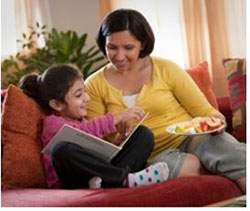How Do I Teach My Children to have Good Food Habits?
By: Mary Ellen Fleming, Family & Consumer Science Agent, San Luis Valley Area
 Children are not born knowing how to choose nutritious foods. Their early experiences with food will influence their choices and attitudes toward food later in life. The first and most lasting influences on your child are you and your family.
Children are not born knowing how to choose nutritious foods. Their early experiences with food will influence their choices and attitudes toward food later in life. The first and most lasting influences on your child are you and your family.
To be successful in feeding children, you have to be able to share responsibility with your child:
- Parents are responsible for choosing what foods are offered to their children and when they are offered.
- Children are responsible for how much they choose to eat, even if they don’t eat any of the food.
 Encourage trying new foods by presenting meals and snacks in a fun and positive way. Avoid pestering your child or forcing them to eat the food. Again, it is the child’s responsibility to decide whether to eat a food and how much to eat.
Encourage trying new foods by presenting meals and snacks in a fun and positive way. Avoid pestering your child or forcing them to eat the food. Again, it is the child’s responsibility to decide whether to eat a food and how much to eat.
Bring Home Nutritious Foods:
- Select a variety of meats, eggs, beans, nuts and seeds. This is the protein food group. Often overlooked, nuts, nut butters and seeds make tasty and nutritious snacks. * See cautions for young children.
- Provide plenty of vegetables at meals and snack time. For an easy and popular snack, offer raw vegetables served with ranch dressing or hummus. * See cautions for young children.
- Have fruit available for snacks. Use fresh fruits in place of sugary desserts. Frozen fruits and canned fruits are great too, but read the ingredient label to make sure there are no added sugars.
- Provide water and milk to drink most of the time. Do not make sodas and sugary drinks available at home.
- To make water more interesting, thinly slice a lemon, lime, orange, grapefruit, or other favorite fruit and add to a pitcher of water kept in the fridge.
- Cut fruit juice in half by adding water. Limit 100% fruit juice to 4 ounces a day.
- Choose whole grains when selecting breads and cereals.
- Read the ingredient label and look for “whole” wheat or “whole” grain in the list of ingredients.
A nutritionally complete meal doesn’t have to contain many different foods. It can be as simple as a tuna noodle casserole with spinach and a glass of milk. If your child prefers, everything could be separate, such as meat loaf, mashed potatoes, broccoli, bread and milk.
 Snacking: People often think that snacking is bad for their children and try to prevent eating between meals. That is not necessary or helpful. Children’s energy needs are high, and with a limited stomach capacity, they need to eat every three to four hours. The important thing is that you have control over the time of snacking (not too close to mealtimes) and the type of food that is eaten (nutritious).
Snacking: People often think that snacking is bad for their children and try to prevent eating between meals. That is not necessary or helpful. Children’s energy needs are high, and with a limited stomach capacity, they need to eat every three to four hours. The important thing is that you have control over the time of snacking (not too close to mealtimes) and the type of food that is eaten (nutritious).
Be a good role model: You are your children’s first teacher. Your children will copy your manners, behavior, and food choices. They want to please you. Both children and adults should use good manners.
Let’s Talk
Make mealtime pleasant. Don’t argue, fight or scold at mealtimes, and don’t let anyone else do it either. The more positive mealtime is the more children will enjoy it. Mealtimes are excellent times for sharing thoughts and feelings and for talking about the importance of eating foods that are good for you. If your child eats a small amount in the beginning of the meal and then wants to be excused, a healthy snack should be available later when they are hungry. Just make sure it is not too close to the next mealtime. When food is presented in a relaxed, accepting climate, children’s eating experiences are enhanced. If children are comfortable and calm, they will be more willing to try and enjoy new foods.
Recipes for Health
As was pointed out earlier, choose whole grain breads and cereals. Here is a recipe for homemade wholewheat tortillas. By incorporating whole-wheat flour into the recipe, you are adding fiber, which is a much needed nutrient in the diet. By adding powdered milk to the tortillas, you are sneaking calcium into the diet, an important nutrient especially during times of growth and development. Encourage your child to help make the tortillas for a fun-filled nutrition activity. They can help prepare the dough and roll out the tortillas.
Whole Wheat Tortillas
 Ingredients:
Ingredients:
- 1 ½ cups all-purpose flour
- 1 ½ cups whole-wheat flout
- 2 tsp. baking powder
- 1 tsp. salt
- ½ cup powdered milk
- ½ cup canola oil
- 1 cup lukewarm water
Directions:
- Wash hands and food contact surfaces with soap and water.
- Mix dry ingredients together.
- Add oil to 1 cup water. Mix into dry ingredients until a smooth, pliable dough forms. If dough is sticky, add a dusting of flour. If dough is tough, add a tiny bit more water and work it in.
- Divide into individual balls of dough around 2” in diameter. Using very little flour on board, roll each ball of dough out to about 1/4” thickness.
- Place on ungreased, hot griddle. Tortilla is ready to flip when small bumps appear on dough. Flip and cook until the underside is lightly browned.
- Cool thoroughly before storing in a food storage bag.
*Cautions for young children, under the age of one:
- Nuts, nut products, egg whites, and shellfish present a risk for allergic reaction.
- Nuts, nut butters, grapes, candy, carrots (raw), corn, raisins, cherry tomatoes, olives, popcorn, sausage, hotdogs, and gum present a risk for choking.





